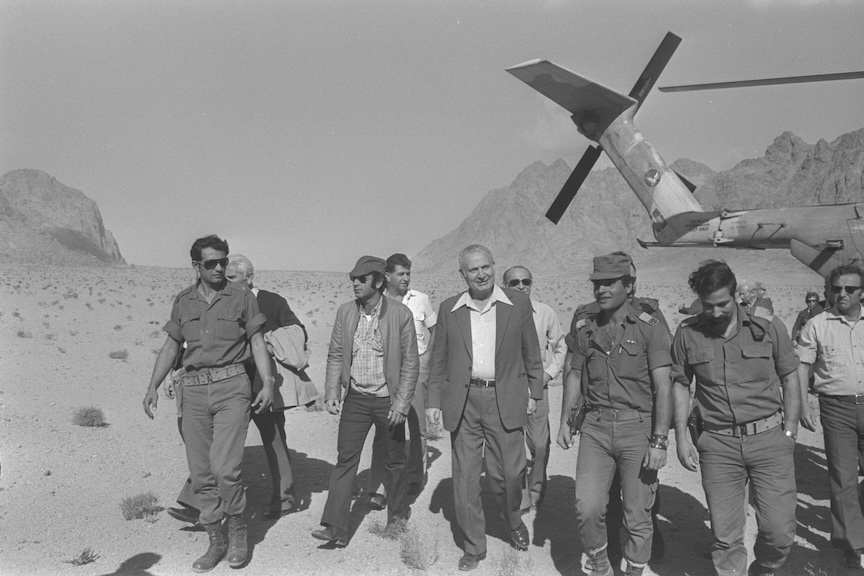1975- Sinai II Agreement

On September 1, 1975 Israel and Egypt Reached an agreement that resulted in the pull back of Israeli forces in the Sinai
Golda Meir had been reelected Prime Minister in December 1973. Shortly thereafter, the initial reports of the Agranat Commission were released, which attributed blame to the military leadership, and not to the political leaders. Despite the Commission’s assessment, public pressure on Golda intensified, and in April 1974, she resigned. Yitzhak Rabin was chosen by the Labor Party’s central committee to replace Meir.
US Secretary of State Henry Kissinger, eager to build on his early disengagement agreements, sought to advance further accords between Israel and its neighbors. It soon became apparent that the only real option was to pursue a further agreement with Egypt. The challenge was that Israel was being asked to give up land, while the most they could expect to get back from Egypt was some form of non-belligerence.
Kissinger explained Israel’s stance to President Gerald Ford, who had replaced President Richard Nixon:
Rabin and the other leaders are grappling with the dilemma of history and logic. The history has been one of pain, anguish, suspicion, suffering, and four costly wars. The logic is that the risks of standpatism are far greater than realistically facing up to necessary step-by-step compromises essential for progress towards a settlement because the choices they [Israel's leaders] will face a year from now if they let the situation drift will be much worse than those they face now. ... We have an abiding interest to support Israel's security; but our interests in the area go beyond any one country.
... Our strategy of segmenting the issues that divide Israel and its neighbors into negotiating units that are politically manageable... is based on the belief that a progressive series of limited agreements could create new situations which in turn will make further agreements possible.
Kissinger worked to persuade Israel to agree to a withdrawal from Sinai in exchanged for assurances from Sadat to refrain from military actions. Kissinger shuttled back and forth between Cairo and Jerusalem.
In March 1975, Kissinger delivered the following letter from Rabin to Sadat:
My people have to know that through the process of withdrawal to a new agreed line we have reached a turning point and that we are now entering an era in which we will be able to settle all our differences by peaceful means only.
As Prime Minister, I must be able to convince both people and the Government in Israel that in surrendering physical strategic positions, we shall not be exposing ourselves to increased hardships created by lengthier and inferior lines in a resumed conflict. This can be possible only if it is visibly shown that the act of withdrawal marks the real beginning of progress toward peace through deeds and words that demonstrate the intention of peace.
Sadat asked Kissinger to orally respond to Rabin by relating:
What I want Yitzhak Rabin to know is the spirit behind the phrases of peaceful intent which we are negotiating. My attitude is that power will never again play a role in the relations of our two peoples. I will try to handle the Arab people if Rabin handles the Israeli people. My determination is to bring about the ultimate withdrawal to agreed lines by peaceful means only. If a Geneva conference is assembled after this agreement is signed, I will not touch this agreement or change anything between us at Geneva. Assure Rabin from my side I am not dreaming of solving this at Geneva.
Whatever the problems, I will not use force. I would be ready to meet Rabin whenever the Israeli occupation of Egyptian territory is ended.
Despite Sadat’s positive statements, an agreement could not be reached. Israel was unwilling to make the concessions that Kissinger believed necessary. Before Kissinger left the region, ending the round of negotiations, Rabin said to him:
I want you to know that the story will not end there. As you reflect on next steps, you should remember this: I feel about every soldier in the IDF (Israel Defense Forces) as if he were my son. And my son is now in the IDF; my son-in-law is commanding a tank battalion in the Sinai.
On the plane home, Kissinger expressed his frustration with Israel’s inability to make the concessions needed. Once he got back to Washington, Kissinger convinced President Ford to talk about the possibility of a reassessment of the US relationship with Israel. The Americans would not give up and continued to push for negotiated agreements. Rabin came to Washington in June and met with Ford. At their meeting Ford opened, saying:
I want to say to you that I am disillusioned; I am disappointed and disturbed. I am disillusioned over the results of last March. I believe that Israel could have been more frank in the crunch. I was disillusioned over the inflexibility of Israel at the final testing point. I understand your political problems in trying to be more forthcoming, but I have to say to you that I was disappointed, disturbed, and disillusioned over the position taken.
Nevertheless, Kissinger pressed ahead to get an agreement and made a breakthrough when it was suggested that the US place Americans at warning stations in the Mitla and Gidi Passes. On September 1, 1975, an agreement was reached. Israel would pull its troops back to the Eastern sides of the Passes, and it would relinquish the Abu Rudies oil field. In return, there would be large areas of the Sinai on the Egyptian side that would be largely demilitarized, and the US would establish the Sinai Support Mission to monitor compliance. Sadat declared, “Let us create a new atmosphere and let us reach the state of nonbelligerent officially and with guarantees.”
 >
>